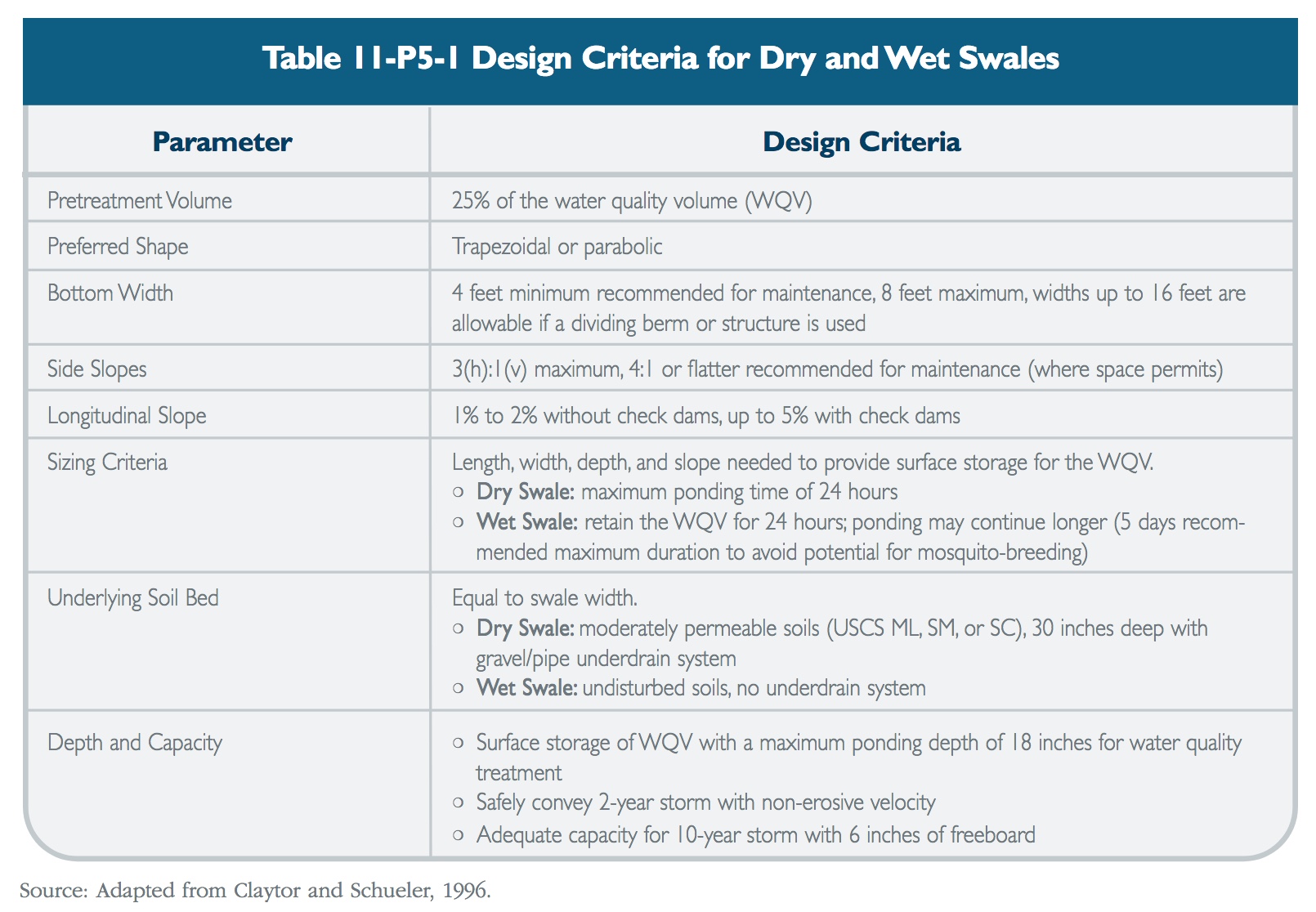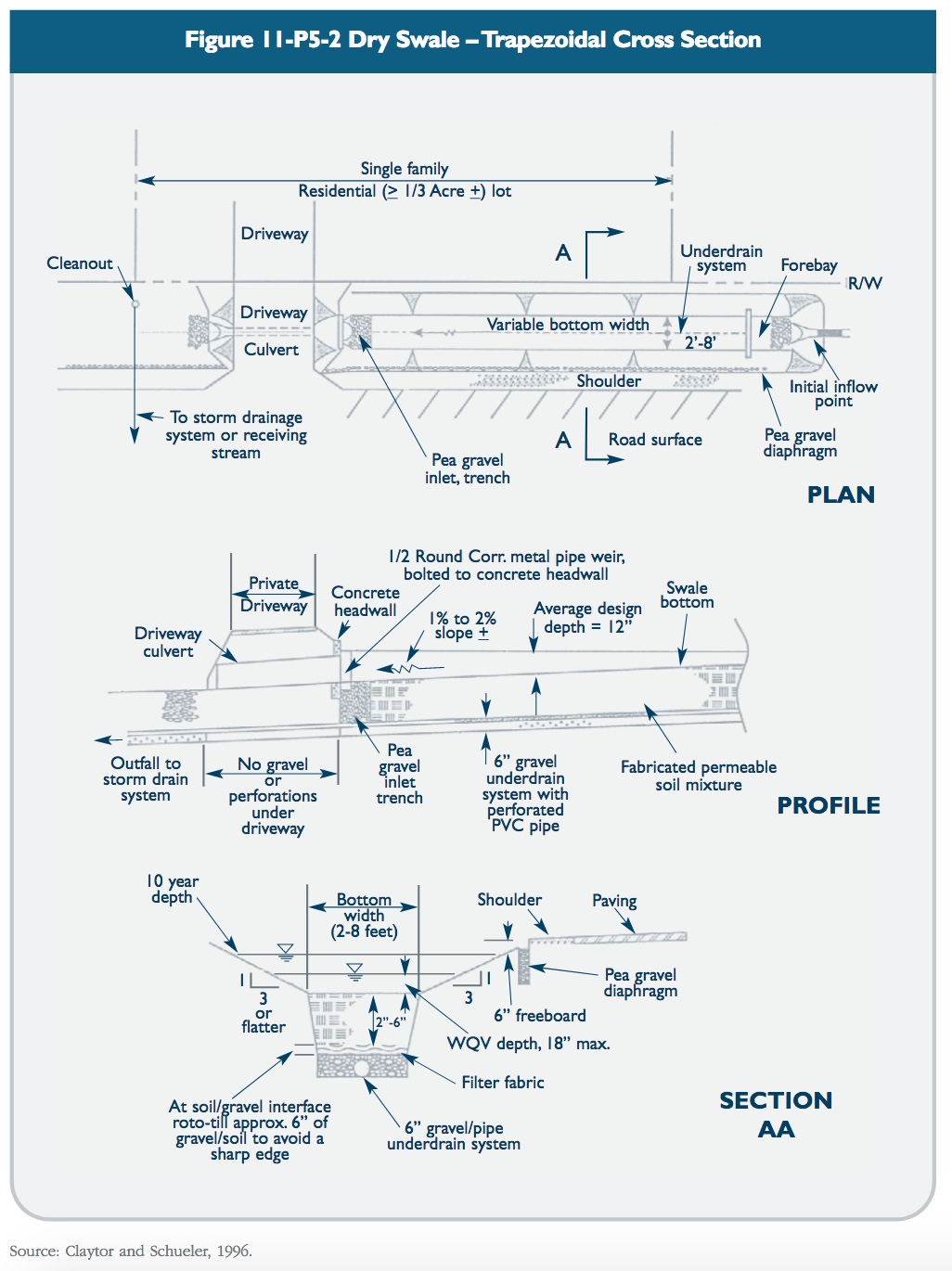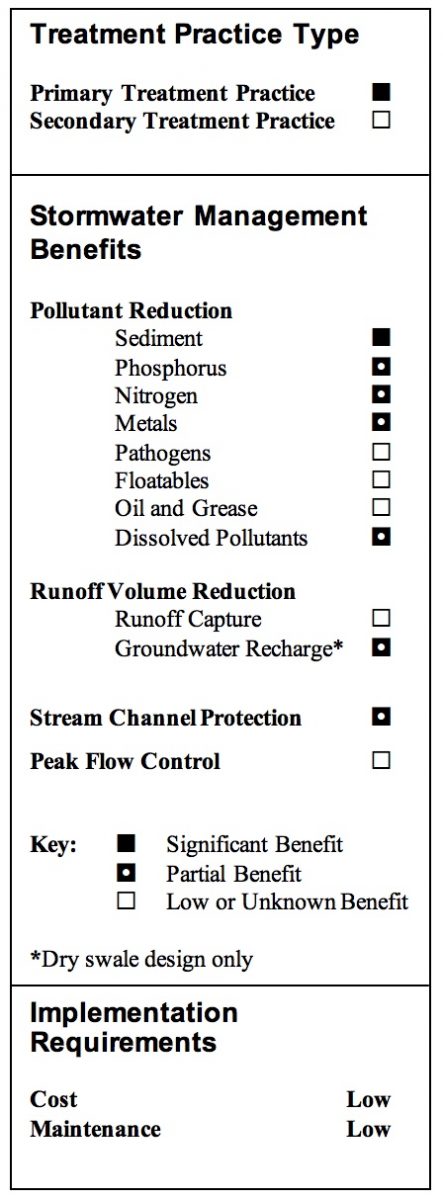Description
Water quality swales are vegetated open channels designed to treat and attenuate the water quality volume and convey excess stormwater runoff. This section includes two types of water quality swales:
* Dry Swale
* Wet Swale
Water quality swales provide significantly higher pollutant removal than traditional grass drainage channels (see secondary treatment practices), which are designed for conveyance rather than water quality treatment.
Dry swales are designed to temporarily hold the water quality volume of a storm in a pool or series of pools created by permanent check dams at culverts or driveway crossings. The soil bed consists of native soils or highly permeable fill material, underlain by an underdrain system. Pollutants are removed through sedimentation, adsorption, nutrient uptake, and infiltration.
Wet swales also temporarily store and treat the entire water quality volume. However, unlike dry swales, wet swales are constructed directly within existing soils and are not underlain by a soil filter bed or underdrain system. Wet swales store the water quality volume within a series of cells within the channel, which may be formed by berms or check dams and may contain wetland vegetation (Metropolitan Council, 2001). The pollutant removal mechanisms in wet swales are similar to those of stormwater wetlands, which rely on sedimentation, adsorption, and microbial breakdown. Water quality swales can be used in place of curbs, gutters, and storm drain systems on residential and commercial sites to enhance pollutant removal, as well as provide limited groundwater recharge, flood control, and channel protection benefits.
Advantages
* Provide pretreatment for other stormwater treatment practices by trapping, filtering, and infiltrating pollutants.
* Generally lower capital cost than traditional curb and gutter drainage systems.
* Reduce the runoff volume through some infiltration and groundwater recharge (particularly for dry swales).
* Can be used to divert water around potential pollutant sources.
* Provide limited peak runoff attenuation and stream channel protection by reducing runoff velocity and providing temporary storage.
* Provide runoff conveyance.
* Linear nature makes swales ideal for highway and residential road runoff.
Limitations
* Require more maintenance than traditional curb and gutter drainage systems.
* Individual dry swales treat a relatively small area.
* May be impractical in areas with very flat grades, steep topography, or poorly drained soils (Metropolitan Council, 2001).
* Subject to erosion during large storms.
* Large area requirements for highly impervious sites.
* May not be practical in areas with many driveway culverts or extensive sidewalk systems (MADEP, 1997).
* Can produce mosquito-breeding habitat if flat slope, poor drainage, or microtopography created during construction or mowing allows pooling of water for more than 5 days.
Siting Considerations
* Drainage Area: The maximum contributing drainage area for water quality swales should be limited to 5 acres. Conventional grass drainage channels designed primarily for conveyance rather than water quality are appropriate for drainage areas up to 50 acres in size (see Secondary Treatment Practices).
* Land Use: Vegetated swales can be readily incorporated into a site drainage plan. Swales are most applicable to low to moderate density land uses such as residential development, small commercial parking lots, and other institutional land uses.
- Dry swales are primarily designed to receive drainage from small impervious areas (small parking lots and rooftops) and rural roads (Claytor and Schueler, 1996).
- Wet swales are primarily used for highway runoff, small parking lots, rooftops, and pervious areas (Claytor and Schueler, 1996). Wet swales may not be appropriate in some residential areas because of the potential for stagnant water and nuisance ponding.
For high density residential, commercial, and industrial land uses, the water quality volume will likely be too large to be accommodated with most swale designs. Swales may be appropriate for pretreatment in conjunction with other practices for these higher density land uses or for stormwater retrofit applications.
* Slopes: Site topography should allow for the design of a swale with sufficient slope and cross-sectional area to maintain non-erosive velocities. In areas of steep slopes, swales should run parallel to contours.
* Soils and Water Table: Dry swales can be sited on most moderately or well-drained soils. The bottom of the swale should be two to four feet above the seasonal high water table. Wet swales should only be used where the water table is at or near the soil surface or where soil types are poorly drained. When the channel is excavated, the swale bed soils should be saturated most of the time.
Design Criteria
Design considerations for dry and wet swales are presented below and summarized in Table 11-P5-1.

Dry Swale
Figure 11-P5-1 and Figure 11-P5-2 depict typical schematic designs of dry swales.


Channel Shape and Slope
* Dry swales should have a trapezoidal or parabolic cross-section with relatively flat side slopes (3:1 horizontal:vertical maximum, 4:1 or flatter recommended for maintenance).
* The channel bottom width should be between two and eight feet for construction considerations, water quality treatment, and to minimize the potential for re-channelization of flow.
* Check dams may be used to increase in-channel detention, provided that adequate capacity is available to handle peak design flows.
* The longitudinal slope of the dry swale should be between one and two percent. Steeper slopes (up to five percent) may be used in conjunction with check dams (vertical drop of 6 to 12 inches). Check dams require additional energy dissipation measures and should be placed no closer than at 50 to 100 foot intervals.
* Pretreatment should be provided to accommodate 25 percent of the water quality volume. Pretreatment generally consists of a sediment forebay behind a check dam between the inlet and the main body of the swale. The check dam and area immediately downstream of the check dam should be underlain by a stone base to prevent scour. The check dam may be constructed of timber, concrete, or similar material. Earth and stone check dams are not recommended since they require more maintenance.
* Outlet protection is required at the discharge point from a dry swale to prevent scour.
Channel Size
* Dry swales should be designed to temporarily accommodate the water quality volume through surface ponding (a maximum depth of 18 inches is recommended). Surface ponding should dissipate within 24 hours.
* Dry swales should be sized to convey the 10-year storm with a minimum of 6 inches of freeboard, and channel slopes and backs should be designed to prevent erosive channel velocities.
Underlying Soils
* Dry swales should have a 30-inch deep soil bed consisting of a sand/loam mixture (approximately 50/50 mix) having an infiltration capacity of at least 1 foot per day.
* Where soils do not permit full infiltration, an underdrain system should be installed beneath the soil layer, consisting of a gravel layer surrounding a longitudinally perforated pipe (minimum 6-inch diameter recommended).
Vegetation
* Vegetation should be designed for regular mowing, like a typical lawn, or less frequently (annually or semi-annually).
* Native grasses are preferred for enhanced biodiversity, wildlife habitat, and drought tolerance. Grass species should be sod-forming, resistant to frequent inundation, rigid and upright in high flows, and salt tolerant if located along a roadway. Wetland species may be used for the bottom of a wet swale. The maximum velocity should not exceed erosive velocities for the soil type and vegetation condition of the channel (see Connecticut Guidelines for Soil Erosion and Sediment Control for maximum permissible velocities). The following grasses perform well in an open channel environment:
- Red Fescue (Festuca rubra)
- Tall Fescue (Festuca arundinacea)
- Redtop (Agrostis alba)
- Smooth Bromegrass (Bromus inermis)
- Reed Canarygrass (Phalaris arundinacea L.).
Wet Swale
Figure 11-P5-3 depicts a typical schematic design of a wet swale.

Channel Shape and Slope
* Wet swales should have a trapezoidal or parabolic cross-section with relatively flat side slopes (3:1 horizontal:vertical maximum, 4:1 or flatter recommended for maintenance).
* The channel bottom width should be between four and eight feet.
* Check dams may be used to increase in-channel detention, provided that adequate capacity is available to handle peak design flows.
* The longitudinal slope of the dry swale should be between one and two percent. Steeper slopes may be used in conjunction with check dams (vertical drop of 6 to 12 inches). Check dams require additional energy dissipation measures and should be placed no closer than at 50 to 100 foot intervals.
* Pretreatment should be provided to accommodate 25 percent of the water quality volume. Pretreatment generally consists of a sediment forebay behind a check dam between the inlet and the main body of the swale. The check dam and area immediately downstream of the check dam should be underlain by a stone base to prevent scour. The check dam may be constructed of timber or concrete, and may incorporate v-notch weirs to direct low flow volumes. Earth and stone check dams are not recommended since they require more maintenance.
* Outlet protection is required at any discharge point from a wet swale to prevent scour at the outlet.
Channel Size
* Wet swales should be designed to temporarily retain the water quality volume for 24 hours, but ponding may continue for longer periods (5 days recommended maximum duration to reduce the potential for mosquito breeding) depending on the depth and elevation to the water table. A maximum ponding depth of 18 inches (at the end point of the channel) is recommended for storage of the water quality volume.
* Wet swales should be sized to convey the 10-year storm with a minimum of 6 inches of freeboard, and channel slopes and backs should be designed to prevent erosive velocities.
Underlying Soils
* The soil bed below wet swales should consist of undisturbed soils. This area may be periodically inundated and remain wet for extended periods.
* Wet swales should not be constructed in gravelly and coarse sandy soils that cannot easily support dense vegetation.
Vegetation
* The permanent channel vegetation should be suitable for the site and soil conditions.
* Native grasses are preferred for enhanced biodiversity and wildlife habitat. Grass species should be resistant to sustained inundation and/or a high water table and salt tolerant if located along a roadway. Wetland species are appropriate for the bottom of a wet swale. The maximum velocity should not exceed erosive velocities for the soil type and vegetation condition of the channel (see Connecticut Guidelines for Soil Erosion and Sediment Control for maximum permissible velocities). The following grasses perform well in an open channel environment:
- Red Fescue (Festuca rubra)
- Tall Fescue (Festuca arundinacea)
- Redtop (Agrostis alba)
- Smooth Bromegrass (Bromus inermis)
- Reed Canarygrass (Phalaris arundinacea L.).
Construction
* Avoid soil compaction and the creation of microtopography that could result in pooling of water for more than 5 days.
* Accurate grading is critical to the proper functioning of the swale and will affect the treatment performance.
* Temporary erosion and sediment controls should be used during construction.
* Appropriate soil stabilization methods should be used before permanent vegetation is established. Seeding, sodding, and other temporary soil stabilization controls should be implemented in accordance with the Connecticut Guidelines for Soil Erosion and Sediment Control.
Inspection and Maintenance
* Plans for water quality swales should identify detailed inspection and maintenance requirements, inspection and maintenance schedules, and those parties responsible for maintenance.
* Inspect swales several times during the first few months to ensure that grass cover is established. Inspect swales semi-annually for the remainder of the first year and after major storm events. Annual inspections are sufficient after the first year.
* The initial sediment forebay should be inspected annually for clogging and sediment buildup. Sediment buildup should be removed when approximately 25 percent of the water quality volume or channel capacity has been exceeded. Excessive trash and debris should be removed and disposed of in an appropriate location.
* The vegetation along the swale bottom and side slopes should be inspected for erosion and repaired (seeded or sodded), as necessary.
* Grass should be mowed on a regular basis, but at least once per year. Dry swales should be mowed as required to maintain grass heights of 4 to 6 inches during the growing season. Wet swales, which typically incorporate wetland vegetation, require less frequent mowing. Mowing should not be performed when the ground is soft to avoid the creation of ruts and compaction, which can reduce infiltration and lead to poor drainage.
Cost Considerations
Limited data exist on the cost to implement water quality swales, although they are relatively inexpensive to construct compared to other stormwater treatment practices. The cost to design and construct most water quality swales can be estimated as $0.50 per square foot of swale surface area, based on 1997 prices (EPA, 1999). These costs should be adjusted for inflation to reflect current costs.
References
Center for Watershed Protection (CWP). 2000. The Vermont Stormwater Management Handbook Technical Support Document – Public Review Draft. Prepared For Vermont Agency of Natural Resources.
Claytor, R.A. and T.R. Schueler. 1996. Design of Stormwater Filtering Systems. Center for Watershed Protection. Silver Spring, Maryland.
Massachusetts Department of Environmental Protection (MADEP) and the Massachusetts Office of Coastal Zone Management. 1997. Stormwater Management, Volume Two: Stormwater Technical Handbook. Boston, Massachusetts.
Metropolitan Council. 2001. Minnesota Urban Small Sites BMP Manual: Stormwater Best Management Practices for Cold Climates. Prepared by Barr Engineering Company. St. Paul, Minnesota.
United States Environmental Protection Agency (EPA). 1999. Preliminary Data Summary of Urban Storm Water Best Management Practices. EPA 821-R-99-012, Office of Water. Washington, D.C.
